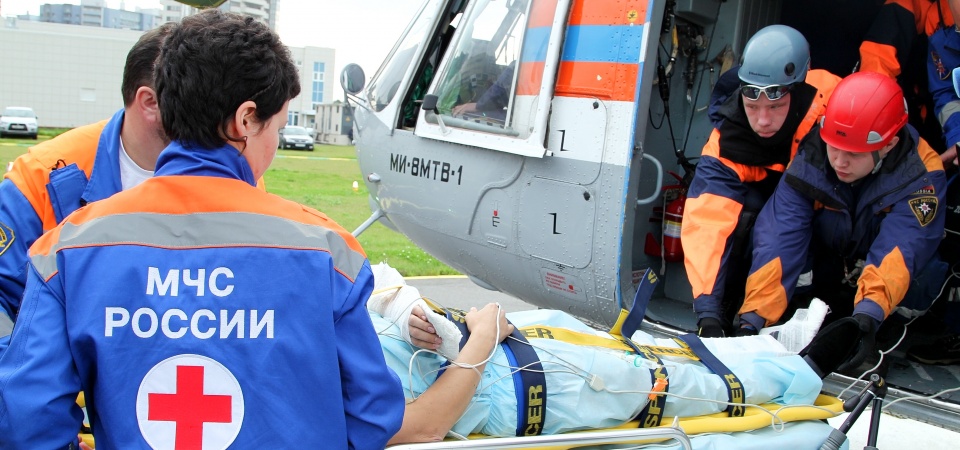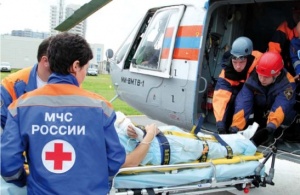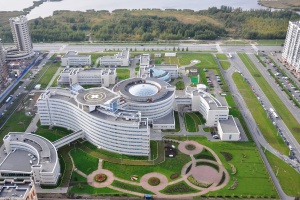

Report: S. ALEKSANIN
NIKIFOROV RUSSIAN CENTER OF EMERGENCY AND RADIATION MEDICINE EMERCOM OF RUSSIA: PAST, PRESENT, FUTURE
There are hundreds of natural and industrial disasters occurring annually. People involved suffer and die. Direct damage amounts to billions of Euros. Emergencies psychological traumas effect the entire population. The Russian Federation has always been actively involved in cases of emergencies. A
special attention is paid to the nuclear power plants accidents. The largest radiation accidents in history are without any doubt those of the Chernobyl and Japanese Fukusima-1 power plants .
The work on studying medical consequences of Chernobyl nuclear power plant accident started after the very first days. Over forty leading Russian institutions were involved in recovery works. Chernobyl accident studies considering medical consequences were carried out, including research under the auspices of the WHO, IAEA, UNESCO, КЕС and other international organizations.
On September 12th 1991 the Government of Russia resolved to establish a Russian Center of Ecology Medicine (RCEM) in Saint-Petersburg. In 1997 RCEM was reformed into the Federal State Institute of Public Health “Russian Center of Emergency and Radiation Medicine” The Ministry of Russian Federation for Civil Defence, Emergencies and Elimination of Consequences of Natural Disasters (RCERM EMERCOM of Russia).
Nowadays the Center bears the name of its founder and first director professor Aleksei Nikiforov (1991-2006), PhD, Corresponding Member of the Russian Academy of Medical Science, Honored Doctor of the Russian Federation: Nikiforov Russian Center of Emergency and Radiation Medicine EMERCOM of Russia (NRCERM EMERCOM of Russia).
The Center performs the following main activities:
•Medical and diagnostic work with a full comprehensive treatment, diagnostics and rehabilitation provided for victims of radiation accidents, Russian EMERCOM specialists and their families as well as for population of Saint-Petersburg and Russia;
•Expert work for determination of health state causation with accident effect;
•Research work (research and research results implementation into clinical practice);
•Education including post-graduate specialized studies and advanced trainings for medical personnel of Russian EMERCOM;
•International cooperation: since 1995 NRCERM EMERCOM of Russia is the World Health Organization Collaborating Centre for Treatment and Rehabilitation of Nuclear and Other Disasters Recovery Workers being also a member of the WHO International Radiation Emergency Medical Preparedness and Assistance Network (REMPAN) since 1998. The Center also participates in a number of other international programs.
The Center has highly qualified specialists, 535 doctors. Many of them underwent advanced trainings in the world leading medical institutions. There are over 50 specialists with the first doctoral degree (PhD), over 45 of them are professors; and over 180 specialists with the second doctoral degree (so called Candidate of Science). Over 75 % of doctors and nursing staff have the highest and first qualification categories.
Clinic No. 1 located in the center of Saint-Petersburg is a specialized therapy multidisciplinary inpatient hospital for 120 beds including:
·Clinical Department of Gastroenterology and Hepatology;
·Clinical Department of Therapy and Industrial Pathology;
·Clinical Department of Cardiology;
·Intensive Care Department.

Clinic uses dosemeter-diagnostic measuring complex, the highly sensitive low-background spectrometer of the human radiation (SICH-E). It is developed by Russian scientists and is aimed at fast life-time measuring of radioactive substances in the human body. Measuring their presence, quantity and distribution in organs and tissues allows detecting a full complex of radionuclides including gamma-, beta- and alpha-emitting radionuclides. The measuring complex knows no equals.
The unique equipment is used for mass-spectrometry with inductively coupled plasma providing multi-element analysis of any liquid samples, from trace to percent parts content of such microelements as B, Na, Mg, P, Be, Al, K, Ca, V, Cr, Mn, Fe, Co, Ni, Cu, Zn, As, Rb, Sr, Ag, Cd, Ba, Tl, Pb, Hg, Se, I, Мо, Li, Cs. This is the most sensitive method of detecting chemicals in human body. Over 500 Chernobyl accident recovery workers underwent bioelement study.
Clinic No. 2 of high-tech medical assistance for 410 beds (250 beds - surgery, 110 beds – therapy, 50 – clinical rehabilitation) includes:
·Unit of Emergency Surgery;
·Unit of Anesthesiology, Resuscitation and Intensive Care (38 beds);
·Operational Block (13 ORs);
·Unit of Dialysis and Gravitational Blood Surgery Techniques;
·Unit of Hyperbaric Oxygen Therapy;
·Unit of Functional Diagnostics;
·Unit of Ultrasound Diagnostics;
·Department of Laboratory Diagnostics;
·Department of Radiodiagnostics;
·Department of Endoscopy;
·Department of Traumatology and Orthopedics;
·Department of Cardiovascular Pathology;
·Unit of Neurosurgery;
·Burns Unit (with Plastic Surgery);
·Unit of Urology;
·Unit of Gynecology;
·Unit of Ophthalmology;
·Unit of ENT and Maxilla-Facial Surgery;
·Unit of Thoracoabdominal Surgery;
·Department of Therapy and Integrative Medicine;
·Department of Clinical Neurology;
·Department of Clinical Psychology;
·Department of Restorative Treatment and Clinical Rehabilitation;
·Department of Radiation Medicine, Hematology and Toxicology.
Both clinics are equipped with high-tech diagnostic and treatment facilities for providing specialized medical assistance including high-tech surgeries for victims of radiation accidents and other emergency situations as well as for recovery workers and Russian EMERCOM specialists. Thus, development of methods for somatic pathology diagnosis in Chernobyl accident recovery workers carried out at the Center is of great significance, i.e.
·Use of best medical practice and the newest medical technology for examination allowing differential diagnosis of somatic pathology, specification of unfavorable cardiovascular prognosis as well as detection of the most significant factors of cerebrovascular pathology development;
·Estimation of Helicobacter pylori gastritis incidence and high frequency of intestinal metaplasia;
·Use of modern technology for examination allowing detection of oncopathology, cerebral tumor, tuberculous process reactivation at the earliest possible stages;
·Differential diagnosis carried out to distinguish among chronic obstructive lung disease, chronic bronchitis and bronchial asthma allowing therapy correction;
·Bioelement imbalance analysis has showed significant disorder of mineral metabolism requiring obligatory correction for 72.6% of examined people;
·Immune status estimation has showed not only predisposition to autoimmune pathology development but also presence of secondary immunodeficiency which needs the prescription of replacement and immune-enhancing therapy.
Since its foundation the Center has provided expert examination, treatment and rehabilitation to more than 25,000 victims of radiation accidents and disasters, mainly Chernobyl accident recovery workers residing in different regions of the Russian Federation.
North-Western Regional Center of the National Radiation and Epidemiological Registry (NRER) operates at NRCERM EMERCOM of Russia providing with information support, quality and efficiency improvement in research of structure, character, dynamics and development of incidence, invalidity and death rate of the examined groups. It includes:
·Chernobyl accident recovery workers;
·People evacuated of the restricted zone;
·Residents of the observed territories;
·Recovery workers’ children.
As of today NRER includes the data on health state of 16,373 people including 11,486 Chernobyl accident recovery workers residing in the North-Western Region of Russia. There was created and now is being maintained database with detailed medical examinations including at the moment information on 700 Chernobyl accident recovery workers.
NRCERM EMERCOM of Russia pays significant attention to radiation emergency preparedness and response planning. Center has as its structural part a Unit of Emergency Specialized Medical Assistance with land and air medical transport and highly qualified specialists. This unit is working 24/7 and has the following capabilities:
·Medical assistance for patients with varying severity during medical transportation using air, sea, railway or land vehicle;
·Evacuation and medical assistance during transportation on the territory of Russia as well as on territories of neighboring countries and beyond;
·Visit any district of Saint-Petersburg and Leningrad Region;
·Medical assistance at mass events;
·Performing resuscitation, monitoring, infusion therapy wherever as well as during transportation.
Clinic No. 2 has a special toxic-radiological block with Department of Nuclear Medicine and Department of Radiation Medicine, Hematology and Toxicology.
The Department of Nuclear Medicine is aimed at diagnosis and treatment of different types of surgery and therapy pathologies using radionuclide methods. There is also own production of radiopharmacy preparations for cyclothrone.
Department of Radiation Medicine, Hematology and Toxicology provides 24/7 specialized medical assistance for patients exposed to chemical or radiation factors at accidents and other emergencies. Department can receive up to 600 patients annually.
Department includes:
1. Unit of Hematology and Bone Marrow Transplantation with:
·Admission Office for victims of radiation accidents;
·Block with sterile wards for bone marrow transplantation and treatment of patients with hemogenesis depressions;
·Boxes for patients with cytopenia conditions and weak immunity;
·Operation room and dressing room for providing with surgical assistance to victims with combined traumas as well as for bone marrow taking;
·Resuscitation room, room for intensive therapy, room for extracorporeal blood purification therapy for treatment of patients with toxic damages, bone marrow and multiorgan failure;
·Hyperbaric chamber for treatment of patients with toxic complications;
·Express laboratory;
·Toxic and Chemical Laboratory;
·Functional Diagnostics Room;
·Inhalation Therapy Room for patients with lungs damage;
2. Laboratory of Cell Medical Technologies.
Main activities of the Department include:
·Providing high-tech specialized medical assistance for victims of radiation accidents, as well as in case of mass destruction due to natural or industrial disasters;
·Treatment of acute and chronic radiation syndrome as well as oncohematological diseases due to radiation or other effect to human genome;
·Providing with radiation safety to Russian population via creating the Registry of HLA-typing donors of EMERCOM of Russia and stem cells bank;
·Hematopoietic stem cells transplantation for treatment of hemogenesis depressions, leukemia, lymphomas, hereditary and evoked genetic diseases, immune deficiency;
·Obtaining mesenchymal stem cells, keratinocytes and dermal fibroblasts for rendering treatment of burns to civilian population and EMERCOM specialists injured in fires;
·Using positron-emission tomography for targeted high-dose chemotherapy of lymphoproliferative and other tumorous disorders;
·Methods of extracorporeal blood purification therapy and barotherapy of toxic complications;
·Supportive therapy and cell therapy of marrowy and multiorgan failure of people injured during natural disasters and man-made catastrophes;
· Cryobank creating.
Center also carries out active research work, i.e
·Basic research in the sphere of medico-biological consequences of radiation accident and other emergencies effects to human body;
·Efficiency and quality improving of existing methods as well as creating new techniques of diagnosis, treatment and prevention of internal diseases caused by different emergency situations factors;
·Medical supply system modernization for rescuer teams of EMERCOM of Russia.

One of the main spheres here is studying basic aspects of low dose radiation effects to human body and long-term consequences of such influence. This issue became up-to-date, unfortunately, after Chernobyl accident. Many years of examinations allowed improving practical work with recovery workers both in diagnostics and treatment. Database has unique material of Chernobyl medico-biological consequences examinations. Although long time past after the accident, Center continues its works on detection of significant differences in health state and giving characteristics of disease progress today.
Over the years of study NRCERM specialists issued many guides, instructions, recommendations, methods, monographs and reports as well as participated in leading conferences and symposia in this sphere and defended PhD theses.
Education activity is performed by the special NRCERM Institute of Extended Professional Training “Extreme Medicine”. Training is carried out in five specialties: Life Safety, Emergency and Radiation Medicine; Clinical Laboratory Diagnostics, Surgery, Internal Diseases and Medical Psychology. Post-graduate professional training is carried out in residency in following programs: Health care organization and public health, anesthesiology and resuscitation, surgery, neurosurgery, traumatology and orthopedics, ophthalmology, therapy, cardiology, gastroenterology, etc.
Over 150 doctors of Russian EMERCOM undergo advanced trainings annually.
Directorship is optimistic about the future. NRCERM has plans for developing Center’s branches in Russian regions, i.e. in Moscow, Kislovodsk, Nizhny Novgorod, Ekaterinburg, Krasnoyarsk and Khabarovsk.
Full information on the Center can be found at webpage http://www.arcerm.ru/en/
AUTHOR
Sergei Aleksanin
PhD in Medicine, Professor, Honoured Doctor of the Russian Federation
Director, NRCERM EMERCOM of Russia
Date: 06/03/2019
Source: Medical Corps International Forum (2/2015)










